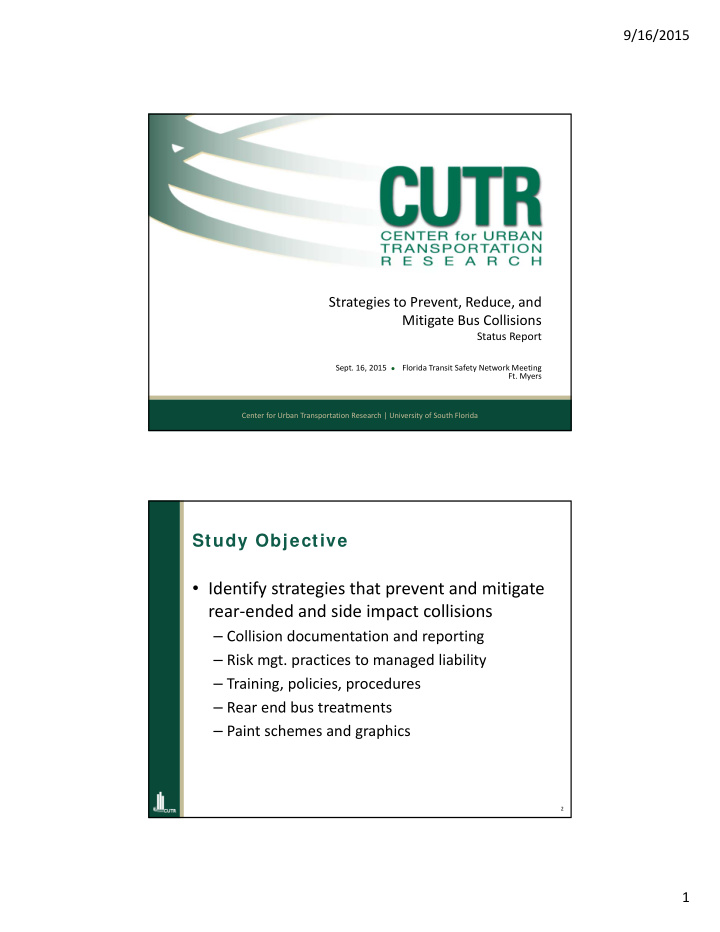



9/16/2015 Strategies to Prevent, Reduce, and Mitigate Bus Collisions Status Report Sept. 16, 2015 Florida Transit Safety Network Meeting Ft. Myers Center for Urban Transportation Research | University of South Florida Study Objective • Identify strategies that prevent and mitigate rear ‐ ended and side impact collisions – Collision documentation and reporting – Risk mgt. practices to managed liability – Training, policies, procedures – Rear end bus treatments – Paint schemes and graphics 2 1
9/16/2015 Tasks • Task 1: Online Survey – 17 transit agencies responded – Questions related to record retention, documentation and reporting • Task 2: Case Studies – Site Visits to 17 agencies • Task 3 Synthesis and Results 3 Agencies Visited Already Visited To Be Visited RTS LYNX VOTRAN Indian River StarMetro St. Johns PSTA SCAT (Brevard) JTA MDT BCT Palm Tran MCAT LeeTran SCAT (Sarasota) HART PCPT 4 2
9/16/2015 Topic Areas Discussed • Accident investigation process • Determination of preventability • Use of video footage • Sharing of accident data w/in agency • Use of accident data for training • GIS mapping of accidents 5 6 3
9/16/2015 7 This study is like… 8 4
9/16/2015 I ’d like to accuse… It was the rookie bus driver, Colonel Mustard, and he was rear ‐ ended on rainy day by a out of state tourist while driving a bus with lots of advertising on the back, and he forgot to turn on his 4 ‐ way flashers. 9 How ever, no sm oking gun so far 10 5
9/16/2015 Seasonal Variation of Accidents 2 0 0 9 -2 0 1 3 40% 35% 30% 25% 20% 15% 10% 5% 0% Winter Spring Summer Fall All Collisions Rear ‐ ended Collisions SideCollision/Side Swipe 11 W eather Conditions All Collisions Clear Cloudy Foggy Clear, 86% Raining Rear ‐ ended Collisions Side Impact Collisions Clear, Clear, 87% 86% 12 6
9/16/2015 No geographic trends Source: Regional Transit System 13 Som e correlation to revenue m iles 140 This means revenue R² = 0.4337 miles account for 120 about 43% of the variation in rear ‐ ended 100 collisions. The Rear ‐ ended Collisions remaining 57% is due 80 to other factors. 60 40 20 0 ‐ 50,000,000 100,000,000 150,000,000 200,000,000 Revenue Miles 14 7
9/16/2015 Som e correlation to revenue m iles 70 This means revenue R² = 0.5787 miles account for 60 about 58% of the variation in side impact 50 collisions. The Side Impact Collisions remaining 42% is due 40 to other factors. 30 20 10 0 ‐ 50,000,000 100,000,000 150,000,000 200,000,000 Revenue Miles 15 No correlation to rear advertising Rear ‐ Ended Collisions per 100,000 Miles SCAT .02 MDT .02 16 8
9/16/2015 No correlation to rear advertising Rear ‐ Ended Collisions per 100,000 Miles SCAT .02 LeeTran .14 17 No correlation to operator’s years of experience Years of No. of Rear ‐ Percent Experience ended Collisions Less than 2 Years 21 27% 2 to 5 Years 10 13% More than 5 Years 48 61% Total 79 100% Source: BCT; data was compiled from 8/2014 to 7/2015. 18 9
9/16/2015 Observations from the Site Visits • Collision investigation process is very similar across agencies. • Variation in preventability assessment – HART: Mgr. of Safety and Security – Sarasota: 4 ‐ person committee (2 from mgt. and 2 from union) – LeeTran: Deputy Director and Senior Ops Supervisor 19 Observations from the Site Visits • Most rear ‐ ended collisions occurred when the bus was already stopped. • “I didn’t see the bus,” most common excuse heard by supervisors. • Video footage standard part of investigation – Not all agencies have telemetry with videos – No agency has rear facing cameras that could capture moment of impact 20 10
9/16/2015 Observations from the Site Visits • All agencies report monitoring collision trends to inform training and adjusting stops. • Communication is key – PSTA places samples of broken equipment in the drivers’ room with the price tag – RTS and SCAT has periodic “all hands” meeting with the director – RTS has FYI form drivers can use to inform mgt. about any unsafe conditions 21 Observations from the Site Visits • LeeTran reported many rear ‐ ended collisions occur in less urban parts of service area where speed limits are higher. – Worth investigating further. • Need to address distracted driving – CUTR has received feedback from agencies in support of statewide campaign 22 11
9/16/2015 Statew ide Cam paign? We already have… Why not a similar campaign for buses? 23 Next Steps • Complete last 4 site visits by Oct. 16 (tentative) – LYNX – Indian River – St. Johns – SCAT (Brevard) • Draft Final Report by Dec. 25, 2015 • Final Report by March 25, 2016 24 12
9/16/2015 Contact I nform ation Brian Pessaro, AICP Senior Research Associate Center for Urban Transportation Research University of South Florida (813) 974 ‐ 5113 pessaro@cutr.usf.edu 25 Accident 1 26 13
9/16/2015 Accident 2 27 14
Recommend
More recommend